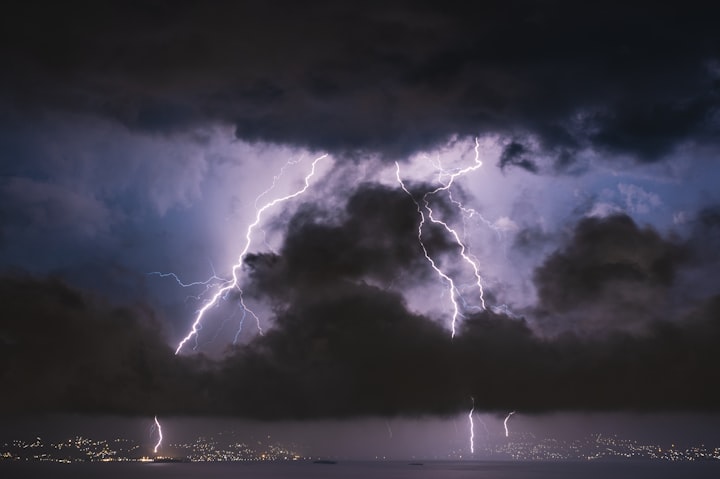Unveiling the Fury of Nature: Understanding Severe Thunderstorms
Severe weather • Thunderstorm

Title: Unveiling the Fury of Nature: Understanding Severe Thunderstorms
Introduction:
Nature's awe-inspiring beauty is often accompanied by its raw power, and few phenomena encapsulate this dichotomy as vividly as severe thunderstorms. These atmospheric juggernauts, characterized by intense lightning, torrential rainfall, powerful winds, and sometimes hail or tornadoes, are among the most captivating yet dangerous weather events on Earth. In this article, we delve into the intricate dynamics of severe thunderstorms, exploring their formation, behavior, and the profound impact they have on both the environment and human civilization.
Understanding Thunderstorms:
At its core, a thunderstorm is a localized weather system characterized by the rapid upward movement of warm, moist air and the subsequent release of energy in the form of thunder, lightning, and precipitation. While most thunderstorms are relatively benign, severe thunderstorms are a different breed altogether, capable of unleashing a barrage of destructive forces that can wreak havoc over vast areas.
Formation of Severe Thunderstorms:
Severe thunderstorms typically develop in environments where specific atmospheric conditions converge to create an explosive cocktail of instability and moisture. Key ingredients include ample moisture at lower levels of the atmosphere, an unstable atmosphere characterized by steep lapse rates (temperature decreases with altitude), and a trigger mechanism such as a cold front, warm front, or dryline.
As the sun's energy heats the Earth's surface, pockets of warm, moist air begin to rise, forming towering cumulonimbus clouds. As these clouds ascend to higher altitudes, they undergo a complex series of processes, including condensation, ice crystal formation, and electrical charge separation, culminating in the electrifying display of lightning and thunder that defines a thunderstorm.
Characteristics of Severe Thunderstorms:
What sets severe thunderstorms apart from their less intense counterparts is the presence of severe weather phenomena such as damaging winds, large hail, and tornadoes. Supercell thunderstorms, a particularly potent breed of severe thunderstorms, are characterized by rotating updrafts known as mesocyclones, which can spawn violent tornadoes capable of causing catastrophic damage.
The Anatomy of a Thunderstorm:
A typical severe thunderstorm comprises several distinct regions, each playing a unique role in the storm's lifecycle. The updraft region, located at the center of the storm, is where warm, moist air ascends rapidly, fueling the storm's development. Surrounding the updraft is the downdraft region, where cold, dense air descends back to the surface, often producing strong gusty winds and heavy rainfall.
At the periphery of the storm lies the anvil region, characterized by its flat, anvil-shaped appearance. This region marks the uppermost reaches of the storm, where the rising air encounters the tropopause and spreads out horizontally, forming the distinctive anvil cloud that is often visible from miles away.
Impacts and Hazards:
The impacts of severe thunderstorms can be far-reaching and devastating, affecting communities, infrastructure, agriculture, and the environment. The primary hazards associated with severe thunderstorms include:
1. Damaging Winds: Severe thunderstorms are capable of generating straight-line winds in excess of 58 miles per hour (93 kilometers per hour), which can down trees, power lines, and structures, causing widespread damage and power outages.
2. Large Hail: Intense updrafts within severe thunderstorms can loft large hailstones high into the atmosphere, where they accumulate layers of ice before plummeting to the ground at high velocity. Hailstones the size of baseballs or larger can cause extensive damage to crops, vehicles, and property.
3. Flash Flooding: The torrential rainfall associated with severe thunderstorms can overwhelm drainage systems and cause flash flooding in low-lying areas, posing a significant risk to life and property.
4. Lightning: Lightning strikes are a common occurrence during thunderstorms, posing a serious threat to individuals outdoors and increasing the risk of wildfires, power surges, and structural fires.
5. Tornadoes: While not every severe thunderstorm produces tornadoes, the rotating updrafts within supercell thunderstorms can spawn tornadoes of varying intensity, ranging from EF0 (weak) to EF5 (violent), capable of causing catastrophic damage and loss of life.
Mitigation and Preparedness:
Given the destructive potential of severe thunderstorms, it is essential for individuals, communities, and governments to take proactive measures to mitigate risk and enhance preparedness. Some key strategies include:
1. Developing Emergency Plans: Establishing emergency plans and evacuation procedures can help individuals and families stay safe during severe weather events, ensuring that everyone knows how to respond in the event of a tornado warning or severe thunderstorm watch.
2. Investing in Early Warning Systems: Timely and accurate weather forecasts, coupled with advanced warning systems such as NOAA Weather Radio and mobile phone alerts, can provide vital information to residents and emergency responders, allowing them to take appropriate action to protect life and property.
3. Strengthening Infrastructure: Building codes and standards should be updated to ensure that infrastructure, including homes, schools, and critical facilities, is designed to withstand the forces of severe weather, reducing the risk of damage and injury.
4. Enhancing Public Awareness: Education and outreach efforts can raise awareness about the dangers of severe thunderstorms and empower individuals to take proactive steps to protect themselves and their communities. This includes providing information on lightning safety, tornado preparedness, and the importance of seeking shelter during severe weather events.
Conclusion:
Severe thunderstorms are a potent reminder of nature's immense power and unpredictability, capable of unleashing a barrage of destructive forces with little warning. By understanding the complex dynamics of severe weather phenomena and implementing proactive mitigation and preparedness measures, we can minimize the risks posed by these formidable atmospheric juggernauts and build more resilient communities capable of weathering the storm. As we continue to confront the challenges of a changing climate, investing in science, technology, and education will be essential to safeguarding lives, livelihoods, and the environment from the fury of nature's wrath.
About the Creator
WILLIAM DIAGO RODRIGUES
Hi! Everyone out there I am a Online Enterpreneur love to create, write and ellaborate different niches and write different Articles to entertain and help to give and spread the knowledge which i can incalcate through different search Engin






Comments
There are no comments for this story
Be the first to respond and start the conversation.